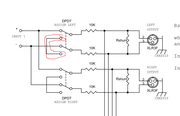Hello, mr. Dave, and all other gurus heere.
I'd like to use Dave's idea from here
http://www.twin-x.com/groupdiy/albums/userpics/balancedmxr.pdf
But I have one question.
If I use small numbers of inputs there is almost no problem, but if I use for example 16 channel there is a little problem. If I use only first channel (for example) and all other are muted, all pairs of 10k resitors (total 20k) are connected to + and - pin of balanced line.
In this case if 15 stereo channels are muted, the total resistance between the balanced line is 20kohm / 15left+15right = 660 ohm!!!
This 660 ohm give me a lot of signal less.
The question is why when the corresponding channel is not used, the resistor pairs are connected?
Here is a picture to illustrate my question:

click for a larger image
Thanks for the support.
Niki
I'd like to use Dave's idea from here
http://www.twin-x.com/groupdiy/albums/userpics/balancedmxr.pdf
But I have one question.
If I use small numbers of inputs there is almost no problem, but if I use for example 16 channel there is a little problem. If I use only first channel (for example) and all other are muted, all pairs of 10k resitors (total 20k) are connected to + and - pin of balanced line.
In this case if 15 stereo channels are muted, the total resistance between the balanced line is 20kohm / 15left+15right = 660 ohm!!!
This 660 ohm give me a lot of signal less.
The question is why when the corresponding channel is not used, the resistor pairs are connected?
Here is a picture to illustrate my question:

click for a larger image
Thanks for the support.
Niki


